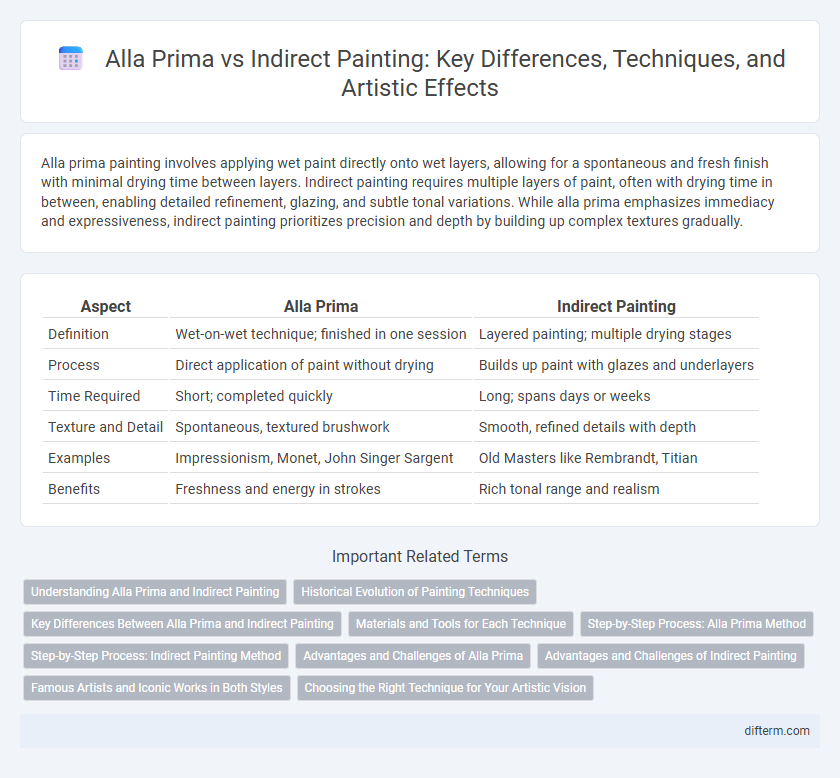Alla prima painting involves applying wet paint directly onto wet layers, allowing for a spontaneous and fresh finish with minimal drying time between layers. Indirect painting requires multiple layers of paint, often with drying time in between, enabling detailed refinement, glazing, and subtle tonal variations. While alla prima emphasizes immediacy and expressiveness, indirect painting prioritizes precision and depth by building up complex textures gradually.
Table of Comparison
| Aspect | Alla Prima | Indirect Painting |
|---|---|---|
| Definition | Wet-on-wet technique; finished in one session | Layered painting; multiple drying stages |
| Process | Direct application of paint without drying | Builds up paint with glazes and underlayers |
| Time Required | Short; completed quickly | Long; spans days or weeks |
| Texture and Detail | Spontaneous, textured brushwork | Smooth, refined details with depth |
| Examples | Impressionism, Monet, John Singer Sargent | Old Masters like Rembrandt, Titian |
| Benefits | Freshness and energy in strokes | Rich tonal range and realism |
Understanding Alla Prima and Indirect Painting
Alla prima painting involves applying wet paint directly onto the canvas in a single session, emphasizing spontaneity and fluid brushstrokes to capture immediate impressions. Indirect painting requires multiple layers applied sequentially, allowing for drying time between sessions to build depth, detail, and refined textures. Mastery of alla prima demands confident, rapid execution, while indirect painting prioritizes planning, layering, and subtle tonal transitions.
Historical Evolution of Painting Techniques
Alla prima, characterized by wet-on-wet application, emerged prominently during the 19th century, revolutionizing portrait and landscape painting with immediacy and vibrant color blending. In contrast, indirect painting, rooted in Renaissance traditions, involves multiple layered glazes and detailed underdrawings, emphasizing precision and longevity. This evolution reflects a shift from meticulous, time-intensive methods toward more spontaneous, expressive techniques that shaped modern artistic practices.
Key Differences Between Alla Prima and Indirect Painting
Alla prima painting involves applying wet paint directly onto wet layers in a single session, emphasizing spontaneity and immediacy, often used for capturing light and atmosphere quickly. Indirect painting consists of multiple layers, starting with an underpainting followed by successive glazes or scumbles, which allows for greater detail, depth, and luminosity through gradual build-up. The key difference lies in the technique's timing and layering: alla prima encourages rapid expression, while indirect painting prioritizes a meticulous, layered approach for refined effects.
Materials and Tools for Each Technique
Alla prima painting demands quick-drying oils, soft brushes, and sturdy canvases to enable swift, wet-on-wet application, ensuring vibrant color blending on the canvas. Indirect painting requires layered materials such as slow-drying oil mediums, fine sable brushes, and smooth, primed panels or linen to support multiple drying stages and precise detail work. Both techniques benefit from high-quality pigments but differ fundamentally in the preparation and drying times dictated by their tools and materials.
Step-by-Step Process: Alla Prima Method
The alla prima painting method involves completing a painting in a single session while the paint remains wet, allowing for bold brush strokes and spontaneous expression. Artists typically begin with a loose underpainting or quickly block in major shapes and values, then build up details and textures directly without waiting for layers to dry. This technique requires confident brushwork and swift decision-making, emphasizing immediacy and freshness in the final artwork.
Step-by-Step Process: Indirect Painting Method
The indirect painting method involves multiple layers, starting with an underdrawing or underpainting to establish composition and values. Artists apply successive translucent glazes or scumbles, allowing each layer to dry thoroughly to achieve depth and luminosity. This step-by-step process enhances color richness and detail precision compared to the alla prima technique, which relies on completing the work in a single wet-on-wet session.
Advantages and Challenges of Alla Prima
Alla prima painting allows artists to complete a work in a single session, capturing fresh, vibrant colors and spontaneous brushstrokes that enhance emotional expression. This technique reduces drying time and enables immediate adjustments, but it challenges artists to work quickly and confidently, often requiring skilled handling of wet paint to avoid muddiness. The immediacy of alla prima demands precision and decisiveness, contrasting with the patience and layering involved in indirect painting.
Advantages and Challenges of Indirect Painting
Indirect painting offers advantages such as enhanced detail control, richer color layering, and greater compositional precision due to its multi-stage process. Artists can correct mistakes and build complex textures by applying multiple thin glazes, which creates depth and luminosity impossible with alla prima techniques. Challenges include increased time investment, the need for patience during drying intervals, and the risk of overworking the artwork, which can diminish spontaneity and freshness.
Famous Artists and Iconic Works in Both Styles
Famous artists like Claude Monet and John Singer Sargent excelled in alla prima painting, creating iconic works such as Monet's "Impression, Sunrise" and Sargent's portraiture that showcase immediate brushwork and vibrant color blending. In contrast, artists like Leonardo da Vinci and Jan van Eyck mastered indirect painting techniques, evident in masterpieces like "Mona Lisa" and "The Arnolfini Portrait," which feature meticulous layering and glazing for depth and realism. Both styles have significantly influenced art history, demonstrating diverse approaches to capturing light, texture, and emotional impact.
Choosing the Right Technique for Your Artistic Vision
Choosing between alla prima and indirect painting hinges on the artist's desired outcome and workflow; alla prima offers a fresh, expressive approach with wet-on-wet layers completed in one session, ideal for capturing spontaneity and emotion. Indirect painting, involving multiple layers with drying time in between, provides depth, precision, and refined detail, favoring artists seeking control and subtle tonal transitions. Understanding these techniques' impact on texture, color blending, and overall style enables artists to align their method with their artistic vision and project goals.
alla prima vs indirect painting Infographic

 difterm.com
difterm.com